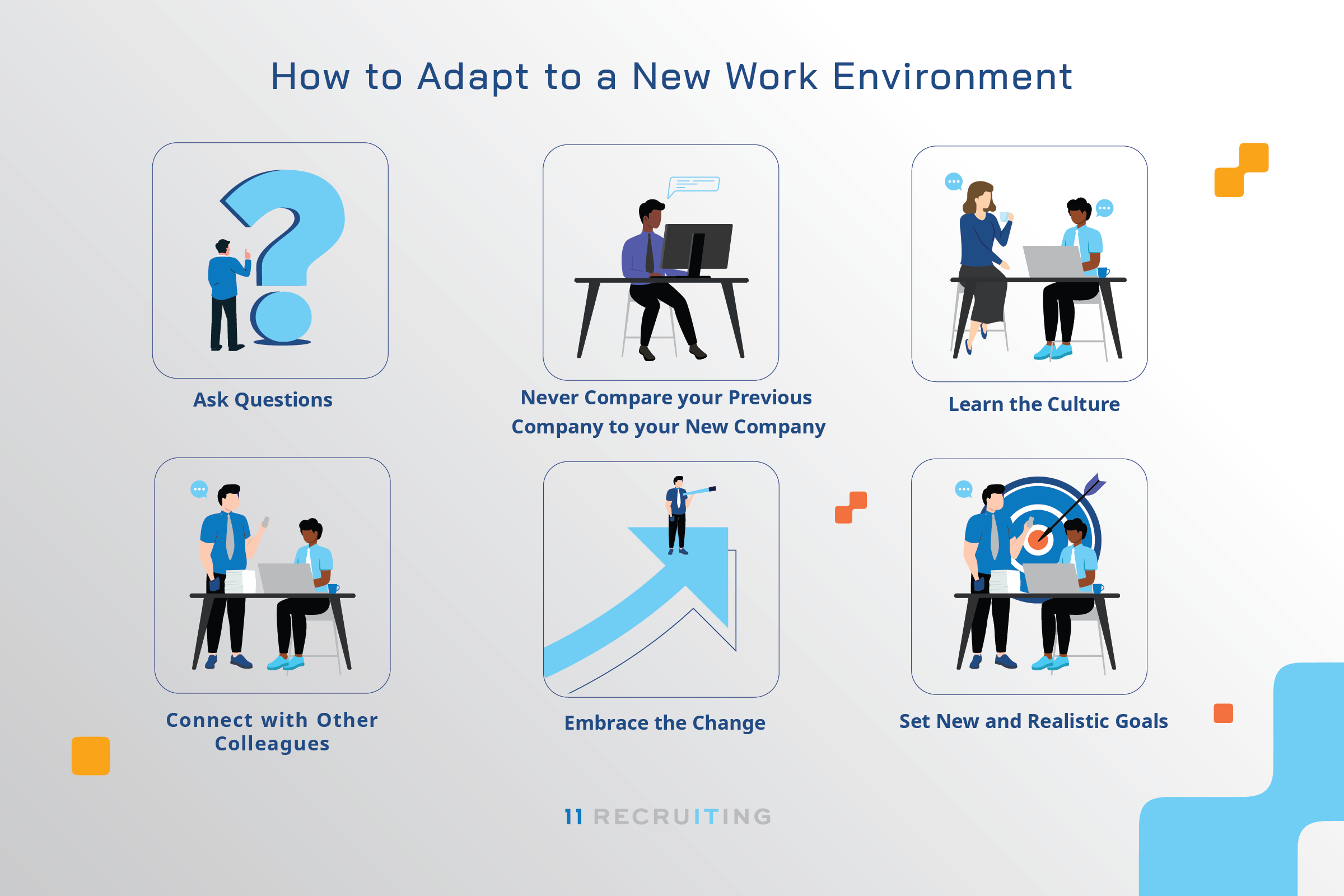
Whether you’re applying to an organization with no work experience, or have been an employee who left their former employer, you’re generally regarded as someone new to a company you want to be a part of. You must understand that changes will occur, but to achieve a good job satisfaction level, you’ll need to know how to adapt to a new work environment.
This article is a guide on how to tune yourself into a new office environment, organizational culture, and why you must adapt to the changes.
Organizational Culture V.S. Office Environment
Many factors influence our level of adaptation to organizational changes. In the same way we have personalities and homes that people adjust to when they enter our space, every company has its organizational culture and office environment that’ll require getting familiar with.
According to Edgar Schein’s organizational culture theory, organizational culture is a system that contains three levels – exposed values, artifacts, and shared tactics assumption, which direct and governs the behaviors of people in the organization. These levels help an employee go through various changes and adapt to the office environment. Also, the office environment is a space created to manifest and maintain the factors that can affect an employee’s day-to-day productivity and job satisfaction level.
In essence, every organization has its unique work elements and culture embedded in its work environment, which affects how you adapt to changes. So if you want to adapt to work environment changes, you must understand the organizational culture and other office environment elements like work-life balance, work hours, and values.
Frequently Asked Questions
What is the importance of adapting to a new work environment?
The ability to adapt to a changing work environment allows you to be part of the innovation and growth of the organization. It also helps you become more productive with a positive attitude, as you’ll get accustomed to the organizational culture and system.
Aside from that, knowing how to adapt to a new work environment shows that you can be resourceful, relevant, and have good leadership skills among other things. These are valuable soft skills that every employer looks for in an employee. You’re not only helping yourself grow, but you’re also showing that you can be of value to your organization.
How long does it take to adapt to a new environment?
A study published in the European Journal of Social Psychology claimed that it takes about 66 days for a new behavior to become a habit. So, it takes about two and half months to adapt well to a new work environment and get used to the behaviors and routine. As you may know, the ability to adapt to a changing work environment takes time and patience— it doesn’t happen overnight. Individuals have different personalities, so is their method and time frame of embracing change, so it’s essential that you know your kind of person and how you form new habits.
What makes a creative office environment?
Factors that make a creative work environment include flexible working hours, physical environment, good working conditions, work benefits, encouragement, leadership, development, and work-life balance. All these elements work together to build and maintain organizational culture, as it enables its employees to take risks and share ideas. A creative office environment also helps employees with different skills, learning styles, and personalities to adapt to new work environments and practices that suit their needs.
How to Adapt to a New Work Environment
Getting a new job can be exciting, but adapting is sometimes overwhelming, as change can be challenging. So, here are five tips that will help you adapt to a new work environment.

Ask Questions.
Remember that you’re new, and you’re learning a different process, so there will be many things you’ll have to understand. Use the interview period to ask questions relating to their company’s artifacts. These include visible and identifiable organizational elements such as the workplace design and layout, office languages and jokes, and dress codes. Also consider a company’s espoused values. These come in the form of stated values, philosophies, goals, mission, and rules of behavior that serve as a guide for all the company’s decision-making. Asking questions will help you develop a clear and deeper understanding of the elements that make up the company’s system, and it’ll help you better adapt to this new work environment.
Never Compare your Previous Company to your New Company.
Comparing your current position and organization with your previous one often slows down your adaptation to new office environments and organizational culture. Remember organizations vary; what works in your previous company might not be appropriate in your current one. For instance, a company that runs under an enterprising work environment will be very different from a company that runs under an artistic work environment. Instead of comparing, focus on using your previously learned skills to be productive, and open up to learning new skills to help you ace your job role.
Learn the Culture.
You’ll have to learn and build habits relevant to the organization’s culture. Take time to observe what goes on in the company. Observe how your teammates interact, the languages they use, how they resolve conflicts, and identify what works and what doesn’t.
Connect with Other Colleagues.
Being a new employee at an organization can be intimidating, but to survive, you have to shake off the nerves. I’m not saying you should jump on the bandwagon and be chatty with everyone. Instead, take time to immerse yourself in the new work setting. Engage in a workplace conversation, make a friend or two, get to know your teammates, and, if possible, have a mentor to explain the processes that surround the organization culture.
Connecting with other colleagues will help you adapt and feel more at home with your company’s work environment and culture. It’ll also show your colleagues that you’re approachable and cooperative. This way, you might even learn some essential nuances that you won’t find in an organizational handbook— like where to hide your food.
Set New and Realistic Goals.
Now that you’re in a new office environment with a different organizational culture, you need to rethink some of your previously established goals that don’t align with your new organization. Setting a new and realistic goal will help you refocus your purpose to align with what the company system offers. And, with the new goals, you’ll develop a mindset shift that directs your energy into adapting to the creative work environment and organizational culture of your new company so you can achieve your goals.
Embrace the Change.
Change is essential for growth and success, so if you’re still scared of changes, then you might not be ready for this new job. One way to adapt to a changing work environment is to have an abundance mindset. This mindset emphasizes the flexibility to embrace and adapt to a new work environment and organizational culture. So, do away with the former habits and culture you got from your past employer, and be optimistic that these changes will lead to more positive outcomes, even if it’s initially challenging to navigate.
Key Takeaway…
Knowing how to adapt to a new environment takes time. If you want to adapt well to change, you must accept the fact that it’ll involve some certain level of loss that has to do with undoing certain habits and behaviors you’ve yet to unlearn. Keep in mind, it’s not only about you, it’s also about the organization. Any action or inaction you take will affect the company’s productivity and success.
The global workplace is a competition, so the quicker you get to adapt to your new work environment, the better it is for you, your team, and the company.
Do you have more questions about adapting to a new work environment? Head on to our candidates service page at our eleven recruiting website

